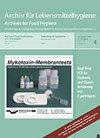Microbiological quality of typical foods served in Thai restaurants in Vienna, Austria
IF 0.2
4区 农林科学
Q4 CHEMISTRY, APPLIED
引用次数: 1
Abstract
The microbiological quality, pH and serving size of typical meals served in 18 Thai restaurants in Vienna were studied. During the summer and winter season, one ready-to-eat food portion was sampled per restaurant and per food category ("A": raw or insufficient heat treatment; "B": heat treated main dish garnished/mixed with raw side-dishes; "C": thorough heat treatment, served alone; total number = 108). In addition, ― where possible ― some typical side dishes were sampled (n = 25). The average weight of main dishes varied dependent on category from 360―510 g. The lowest pH was observed in group "A" (average 4.5), most probably because of the addition of acids via lime juice. Expectedly, group "A" had significantly higher total aerobic counts (6.1 ± 0.8 log cfu/g) than group "B" (4.5 ± 1.7 log cfu/g) and "C" (2.6 ± 0.9 log cfu/g). In side-dishes, average total aerobic counts were higher in raw vegetables (4.9 log cfu/g) than in rice (2.6 log cfu/g). With respect to hygiene indicator bacteria, there was a clear association between presumably insufficient heat treatment and/or the likelihood of cross-contamination (groups "A" "B") on the one hand and the presence of E. coli and Enterobacteriaceae on the other. All 133 samples tested negative for Salmonella spp., Listeria monocytogenes and Campylobacter spp. (25 g aliquots). In groups "A" and "B" the warning limits for total aerobic count and Enterobacteriaceae established by the German Society for Microbiology and Hygiene were exceeded in 30-60 % of the samples. For food classification we used an empirical scheme taking into account heat treatment and the likelihood of cross-contamination, assuming that these two factors would be associated with the risk of presence of pathogenic bacteria in the ready-to-eat food portion. This empirical classification was well reflected in total aerobic counts. As regards pathogens, the usefulness of such a classification scheme could not be evaluated due to the low frequency of pathogens. This indicates that on this issue further studies should be conducted.奥地利维也纳泰国餐馆中典型食物的微生物质量
研究人员对维也纳18家泰国餐馆提供的典型饭菜的微生物质量、pH值和份量进行了研究。在夏季和冬季,每间餐厅和每个食物类别(“A”:生食或未充分热处理;“B”:经热处理的主菜配以/拌以生配菜;“C”:彻底热处理,单独食用;总数= 108)。此外,在可能的情况下,还抽样了一些典型的配菜(n = 25)。主菜的平均重量因类别而异,从360克到510克不等。A组的pH值最低(平均为4.5),很可能是由于通过酸橙汁添加了酸。意料中,A组总有氧计数(6.1±0.8 log cfu/g)显著高于B组(4.5±1.7 log cfu/g)和C组(2.6±0.9 log cfu/g)。在配菜中,生蔬菜的平均总有氧计数(4.9 log cfu/g)高于大米(2.6 log cfu/g)。就卫生指示细菌而言,热处理不足和/或交叉污染的可能性(a组和B组)与大肠杆菌和肠杆菌科的存在之间存在明显的联系。所有133份样本均未检测出沙门氏菌、单核增生李斯特菌和弯曲杆菌(每包25克)。在“A”和“B”组中,30- 60%的样品超过了德国微生物学和卫生学会制定的总需氧计数和肠杆菌科的警戒线。对于食品分类,我们采用了一种考虑热处理和交叉污染可能性的经验方案,假设这两个因素将与即食食品部分中存在致病菌的风险相关。这种经验分类很好地反映在总有氧计数上。至于病原体,由于病原体的频率较低,因此无法评估这种分类方案的有用性。这表明在这个问题上应该进行进一步的研究。
本文章由计算机程序翻译,如有差异,请以英文原文为准。
求助全文
约1分钟内获得全文
求助全文
来源期刊

Archiv Fur Lebensmittelhygiene
工程技术-毒理学
自引率
0.00%
发文量
0
审稿时长
>12 weeks
期刊介绍:
The "Journal of Food Safety and Food Quality“ provides a platform for papers including case studies and discussion papers dealing with topics from all areas of food hygiene (food originating from animals) including dairy hygiene, food monitoring, beef cattle and meat examination, meat hygiene and food technology.
 求助内容:
求助内容: 应助结果提醒方式:
应助结果提醒方式:


